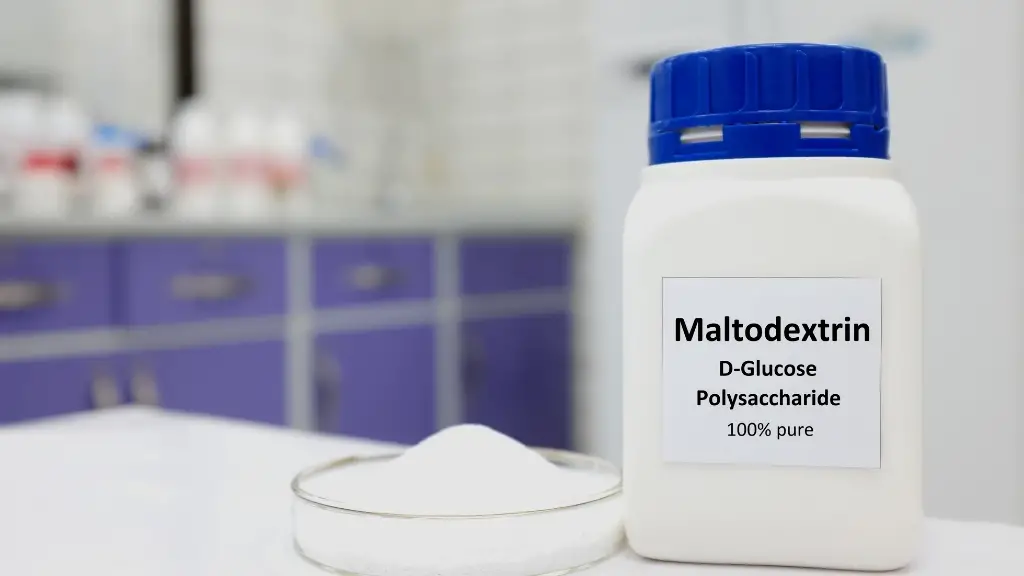Maltodextrin: Side effects and Substitutes

Maltodextrin is one common ingredient you can find in many foods. But is maltodextrin safe? What are maltodextrin dangers? Should you avoid it? Read on to find out.
Maltodextrin is a type of starch that is commonly added to many processed foods. It is a food additive that a lot of us consume without knowing if it is actually good for us! Find out some of the maltodextrin benefits, maltodextrin dangers here, and some alternatives you can use instead.
What Is Maltodextrin?
Maltodextrin is an almost non-sweet white powder that can readily dissolve in water. It consists of short glucose chains and is produced by the breakdown of starch.
What Is Maltodextrin Used for?
Maltodextrin is usually spray-dried and is commercially sold as powders or sometimes even as liquid maltodextrin.
Maltodextrin is inexpensive and is usually used
- As a binding agent to bind ingredients together.
- For thickening foods like sauces, salad dressings, instant puddings, etc.
- To increase the shelf life of foods and help preserve them. ex: In meat products to absorb excess moisture.
- As a sugar replacement in low calorie processed foods.
- As a cryoprotectant to prevent lowering of freezing points of frozen desserts and sugars.
- As an energy source in sports drinks, infant and medical beverages.
- As a humectant and to increase flexibility in soft confections like fruit rolls.
- To modify sugar crystallization and also to prevent sugar bloom in candies.
- For its film-forming nature to improve the adherence of icings to baked products without modifying the sweetness.
Food manufacturers add maltodextrin to a variety of products like
- Nutrition bars
- Chips
- Sauces
- Yogurt
- Spice mixes
- Candies
- Soft drinks
- Sports drinks
- Beer
- Baked goods
- Artificial sweeteners
- Low-calorie foods
- Weight training supplements etc.
Maltodextrin is also used
- As a horticultural insecticide
- In body lotions and hair care products
- In Livestock feed etc.
Applications of maltodextrins in the pharmaceutical industry
- Maltodextrins can be used as a carrier in proniosomes, a novel drug carrier preparation.
- Maltodextrin is a better carrier than sorbitol as it doesn’t interfere with the drug.
- Maltodextrin can also be used as an encapsulation agent since it is readily soluble in water and also shows high retention of flavor.
- It can also be used in fast-dissolving films, as a diluent in tablets.
How Is Maltodextrin Made?
Maltodextrin can be made from any starchy food like potatoes, corn, wheat, rice, tapioca, etc.
Starchy foods are first cooked and then broken down using water, acids, or enzymes like bacterial alpha-amylase to give rise to a neutral-tasting white powder, maltodextrin [1].
Maltodextrin can be comparable to corn syrup solids except maltodextrin has less than 20% sugar.
It can also be produced in the intestines when we digest starchy foods.
Is Maltodextrin Safe to Eat?
Maltodextrin is inert and recognized safe by the United States Food and Drug Administration (FDA) [2]. We also unknowingly consume maltodextrins through foods we eat in our day-to-day life.
Even though maltodextrin is safe, it is a processed carbohydrate. It is best if you consume maltodextrin in limited quantities.
Nutritional Value of Maltodextrin
Maltodextrin gives about 4 Cal/g like any other carbohydrate. It has no nutritional value but is a fast-digesting carbohydrate and can give an instant boost of energy.
It also has a higher glycemic index (GI) than table sugar and can make your blood sugar levels rise quickly.
Potential Health Risks of Maltodextrin
Maltodextrin is recognized as safe for consumption but are there any maltodextrin dangers?
Who should not take maltodextrin?
Few groups of people might want to be cautious of maltodextrin.
Diabetics
Maltodextrin is a fast-digesting carbohydrate. The glycemic index (GI) of maltodextrin is more than that of table sugar. So it can quickly increase your blood sugar levels.
A spike in blood sugar in diabetics can cause many complications and can be fatal too.
However, it doesn’t mean that you avoid maltodextrin completely. You should be fine if you are only including a small amount of maltodextrin in your diet within your daily carbohydrate intake.
A few signs that maltodextrin has increased your blood sugar levels are
- Increased thirst
- Blurred vision or dizziness
- Dry mouth
- Sudden headache
- Trouble concentrating
- Fatigue etc.
In case you experience any of the above symptoms, check your blood glucose levels immediately. If they are too high, call a doctor immediately.
If you are not sure of how maltodextrin will affect your sugar levels, one thing you can do is check your blood sugar levels more frequently when you incorporate maltodextrin into your diet.
Even if you aren’t a diabetic, consuming simple carbohydrates, those with minimal fiber which can quickly enter the bloodstream can increase your risk of type-2 diabetes.
People planning to lose weight
Maltodextrin is essentially a sweetener with no nutritive value. If you are planning to lose weight it is best you don’t consume an excess of maltodextrin as it can quickly make you put on a few pounds.
People who have gluten intolerance
Maltodextrin can also be made from wheat. Even though most of the gluten is lost during processing, always check for the gluten-free label on the cover of your maltodextrin just to be sure.
People who do not want to affect gut bacteria
Gut bacteria play an important role in intestinal inflammatory conditions.
Maltodextrins can also suppress intestinal antimicrobial defense mechanisms. It may increase the number of harmful bacteria and decrease the number of good bacteria. It can also damage the intestinal lining. This can increase the risk of inflammatory bowel disease (IBD) [2].
It can also enhance the survival of salmonella, cause gastroenteritis and other inflammatory conditions.
People who want to avoid Genetically modified foods
Most maltodextrin is commercially produced from corn and the most common type of corn out there is genetically modified. Genetically modified corn is safe to consume according to the US Food and Drug Administration. But if you avoid genetically modified (GMO) foods, you can look for maltodextrin labeled as organic.
People with Maltodextrin allergies
Many food additives can cause food allergies. In rare cases, maltodextrin can also cause allergic reactions like skin rashes, irritation, difficulty breathing, cramping, etc.
Benefits of Maltodextrin
Despite a few potential maltodextrin dangers, there are quite a few maltodextrin benefits.
Since maltodextrin is inexpensive, it is widely used in foods for improving the texture, taste, and shelf life of foods.
Rapid source of energy:
Athletes and bodybuilders who want to gain weight use products containing maltodextrin as it provides a quick source of energy. Maltodextrin can also be used after a workout for gaining instant energy.
Since it is an instant source of energy, it is used in manufacturing sports snacks and drinks. Some studies also mention that it can help maintain anaerobic power during exercise.
Maltodextrin for preventing certain cancers:
A recent study found that a form of digestive-resistant maltodextrin called ‘Fibersol-2’ is effective in preventing tumor cell growth in colorectal cancer without any apparent toxic side effects. This could be due to maltodextrin’s fermentation in the intestines, which could act as an agent that may prevent colorectal cancer.
Maltodextrin for digestion
Digestion-resistant maltodextrin can also improve overall digestion according to a study in the European Journal of nutrition. It can improve the function of intestines like colonic transit time (the time it takes for a substance to move through your colon), stool volume, stool consistency, etc.
Maltodextrin for chronic hypoglycemia
Maltodextrin is also taken in chronic hypoglycemia (low blood sugar levels). This is because it can act as a quick solution to rapidly increase blood sugar levels.
Is Maltodextrin Gluten-Free?
Maltodextrin is generally gluten-free. Even if maltodextrin is made from wheat, the processing that wheat undergoes during the making of maltodextrin renders it gluten-free.
Having said that if you have celiac disease or are on a gluten-free diet, it is best you check the gluten-free label on the packaging.
List of Foods Which Contain Maltodextrin
Let’s now look at maltodextrin in food.
You can find maltodextrin often hiding in plain sight. Some common foods that may contain maltodextrin are:
- Pasta
- Cereals
- Rice
- Soups
- Meat substitutes
- Frozen meals
- Baked foods
- Salad dressings
- Sugars and sweets
- Candies
- Instant dried foods
- Artificial sweeteners
- Energy drinks
- Sports drinks
Alternatives to Maltodextrin
Do you have a sensitive digestive system or feel like the disadvantages of maltodextrin outweigh the benefits? If so, we have a number of other healthier options that you can use as an energy source, for adding flavor or use as binding agents.
Guar gum: It is a low-calorie thickening agent made from guar beans. It can also slow down glucose absorption. It can be used as a substitute in baking.
Pectin: It is found in fruits, seeds, and vegetables and can be used as a thickener to make jams, jellies, etc.
Tapioca starch: It is a gluten-free alternative extracted from cassava root and can be used as a thickening agent.
Dates: They are naturally sweet and are also rich in iron, copper, potassium, magnesium, vitamin B6, etc.
Arrowroot: It is a gluten-free thickening agent derived from the roots of a tropical plant.
Honey: Honey is a nutritious sweetener that can protect you against many illnesses.
Stevia: It is a zero-calorie natural sweetener derived from the leaves of the stevia plant. It is important to check for product labels as some products contain a blend of stevia and maltodextrin.
Sugar alcohols: They have fewer calories than maltodextrin and often have a lower impact on blood sugar levels. They can be found in products labeled as ‘sugar-free’
They include sorbitol, erythritol, etc, and can be used to both sweeten and thicken food.
They are not recommended for those with sensitivity to sugar alcohols as they may cause bloating and diarrhea.
Having mentioned that you can just consider fresh-cut, sliced, or pureed fruits and use them as natural sweeteners while getting bountiful vitamins, minerals, and antioxidants.
Wrapping Up
Maltodextrin is a highly processed, white powdery carbohydrate. It is popularly used in a wide range of food products. But like any other food, it comes with its share of pros and cons.
While maltodextrin is safe for consumption, there are also maltodextrin dangers. Like other simple carbohydrates, maltodextrin can form a part of a healthy lifestyle as long as you limit it and balance it with adequate fiber.
It is best to consider eating whole grains, fruits, and vegetables instead of highly processed foods or empty calories.
FAQs:
Q: Is maltodextrin natural?
A: While maltodextrin is naturally found in a wide range of starchy foods, commercially available maltodextrin is processed.
Q: Does maltodextrin raise blood sugar?
A: Yes! Maltodextrin is a carbohydrate and the glycemic index of maltodextrin is slightly higher than that of table sugar. So it definitely impacts your blood sugar levels.
Q: Is maltodextrin inflammatory?
A: Some studies show that maltodextrin might cause inflammatory disorders and even increase the risk of irritable bowel syndrome.
Q: Are MSG and maltodextrin the same thing?
A: No. MSG (Monosodium glutamate) and maltodextrin aren’t the same. But our bodies may break them down in a similar way. So if you are sensitive to MSG, you might be sensitive to maltodextrin too.
Q: Does maltodextrin contain gluten
A: While maltodextrin generally does not contain gluten, it might contain traces of gluten especially if it is made from a source containing gluten like wheat.
References:
- Hofman, Denise L et al. “Nutrition, Health, and Regulatory Aspects of Digestible Maltodextrins.” Critical reviews in food science and nutrition vol. 56,12 (2016): 2091-100.
- Arnold, Amanda R, and Benoit Chassaing. “Maltodextrin, Modern Stressor of the Intestinal Environment.” Cellular and molecular gastroenterology and hepatology vol. 7,2 (2019): 475-476.
![Blue Foods List [with pictures]](https://keevs.com/wp-content/uploads/2023/03/Blue-Foods-List-with-pictures-300x158.png)






